24 Natural & Serene Wabi Sabi Dining Room Ideas
The Wabi Sabi philosophy, rooted in Japanese aesthetics, embraces beauty in imperfection, naturalness, simplicity, and the passage of time.
Applying these principles to a dining room transforms it into a space of calm and authenticity, fostering a connection with nature and understated elegance.
This article explores 24 design ideas that integrate Wabi Sabi elements, focusing on natural materials, subdued palettes, and a serene atmosphere, to create a dining environment that is both functional and deeply comforting.
1. A Serene Dining Room with Tatami and Shoji Screens
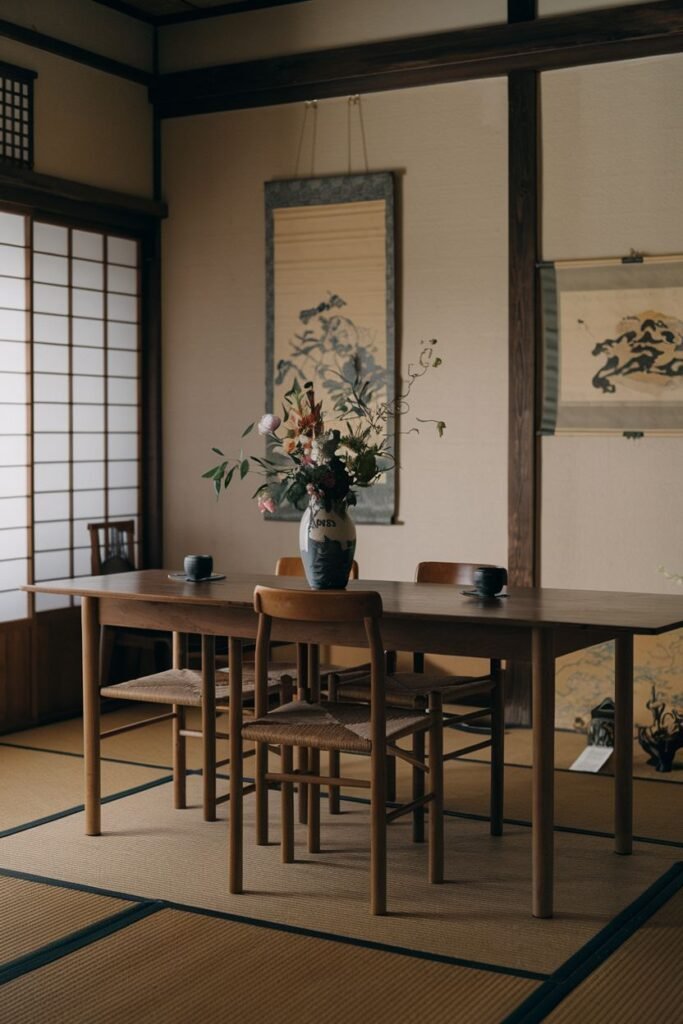
Create a peaceful atmosphere by incorporating tatami mats on the floor and shoji screens on the walls. Place a simple wooden table and chairs with woven seats centrally. Arrange a vase with flowers and branches on the table for a touch of nature. Include minimalistic decor like wall hangings with paintings.
2. Embrace Natural Materials in Your Wabi Sabi Dining Room
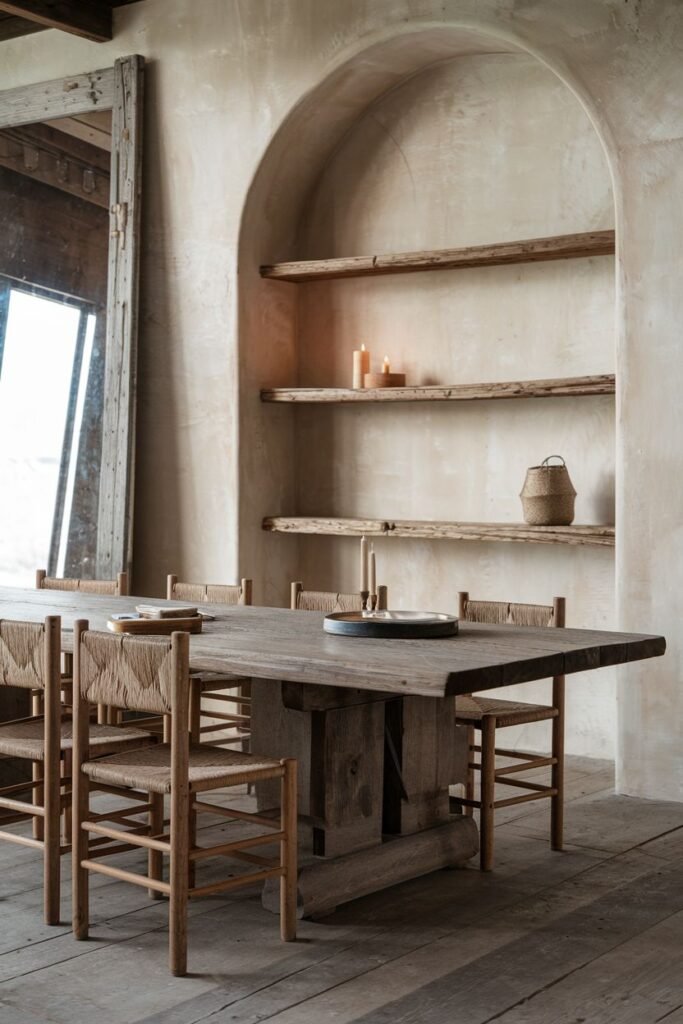
Feature a large, sturdy dining table made from rough, natural wood. Surround it with chairs featuring woven seats. Build recessed shelves in the wall to display simple items like vases and candles. Ensure the walls have a textured, natural plaster finish.
3. Incorporate Rustic Elegance with Calligraphy

Use a dark, rustic wooden table with a substantial base. Pair it with chairs that have woven or cane backs and upholstered seats. Hang large scrolls with calligraphy on the wall to add cultural depth. Display a vase with dried flowers on the table.
4. A Simple and Natural Dining Setting
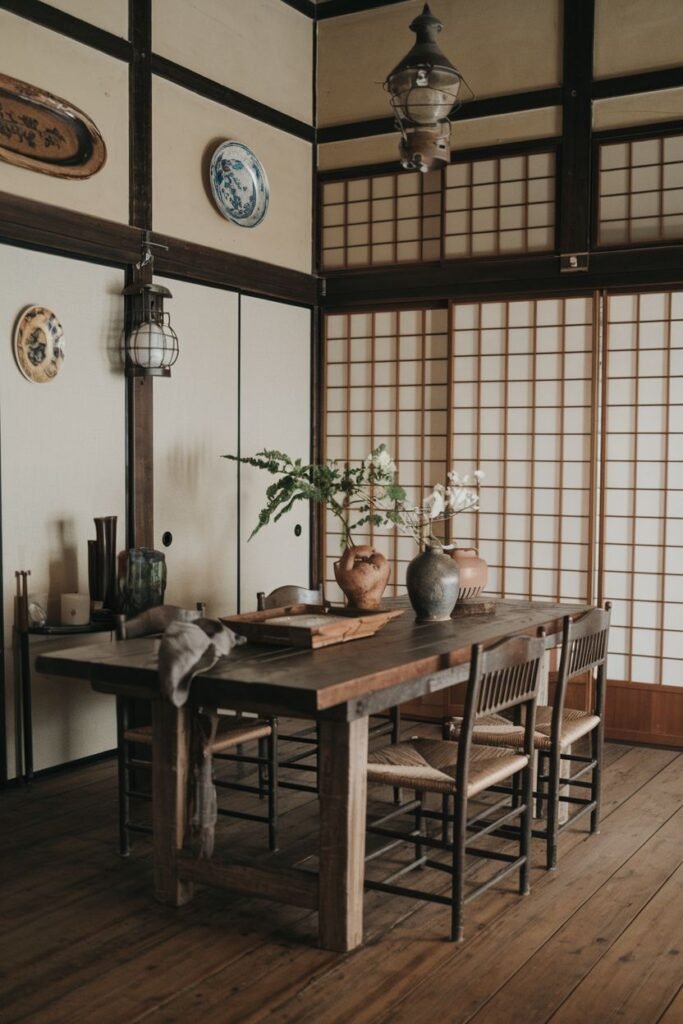
Select a solid wooden table and chairs with woven seats. Dress the table with minimalistic decor such as a vase with greenery and a cloth. Utilize shoji screens on windows or as room dividers. Hang ** lanterns or vintage lighting fixtures** for ambient light. Decorate the walls with simple, decorative plates.
5. Highlight Raw Wood Beams and Textured Walls
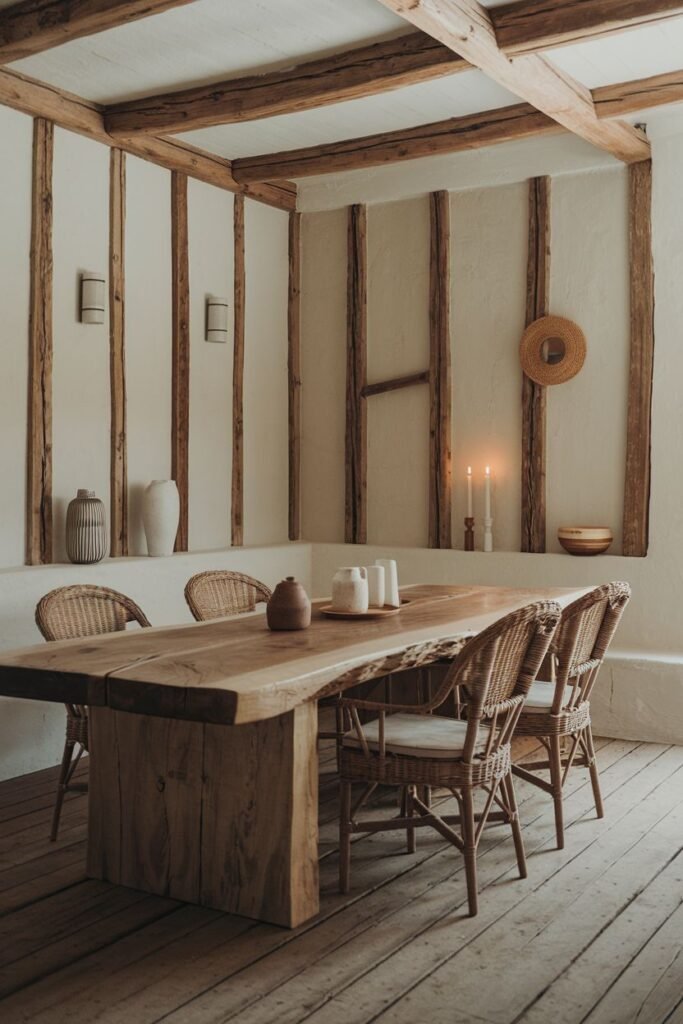
Feature a long, live-edge wooden table with a thick, natural base. Arrange wicker chairs around the table. Showcase the exposed wooden beams on the ceiling and textured, uneven walls. Place minimalistic vases and candle holders on the table and nearby surfaces.
6. Design a Tranquil Outdoor-Inspired Dining Area
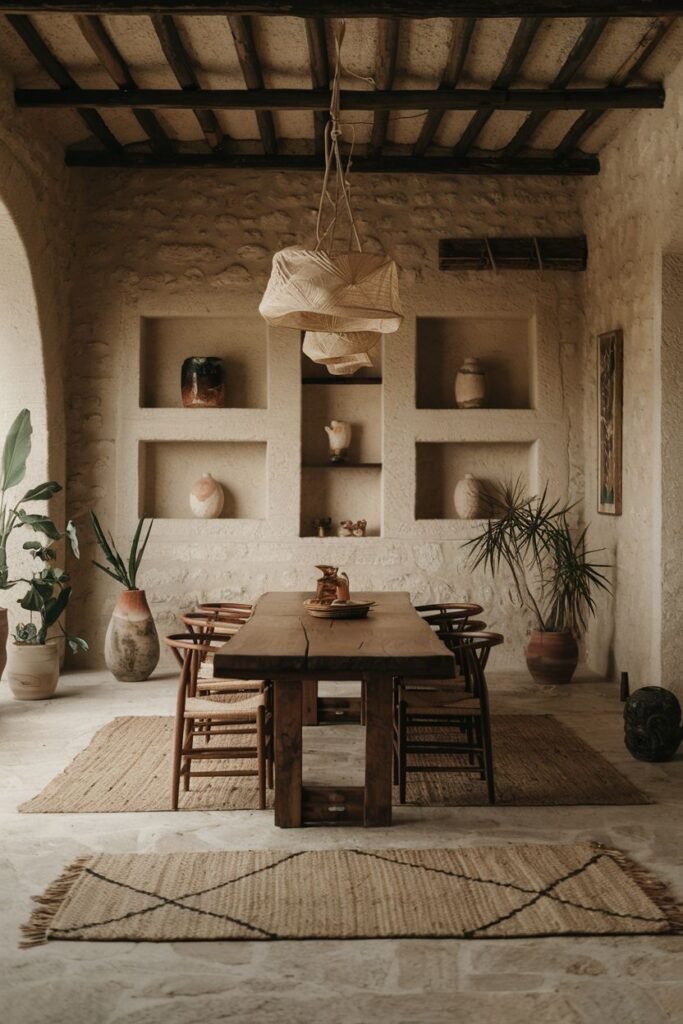
Set up a sturdy wooden table and chairs on a stone or concrete floor. Lay down natural fiber rugs to define the space. Incorporate built-in wall niches to display vases and decorative objects. Bring in large potted plants to enhance the natural feel. Hang a woven light fixture from the ceiling.
7. A Serene Natural Dining Room with Lots of Greenery
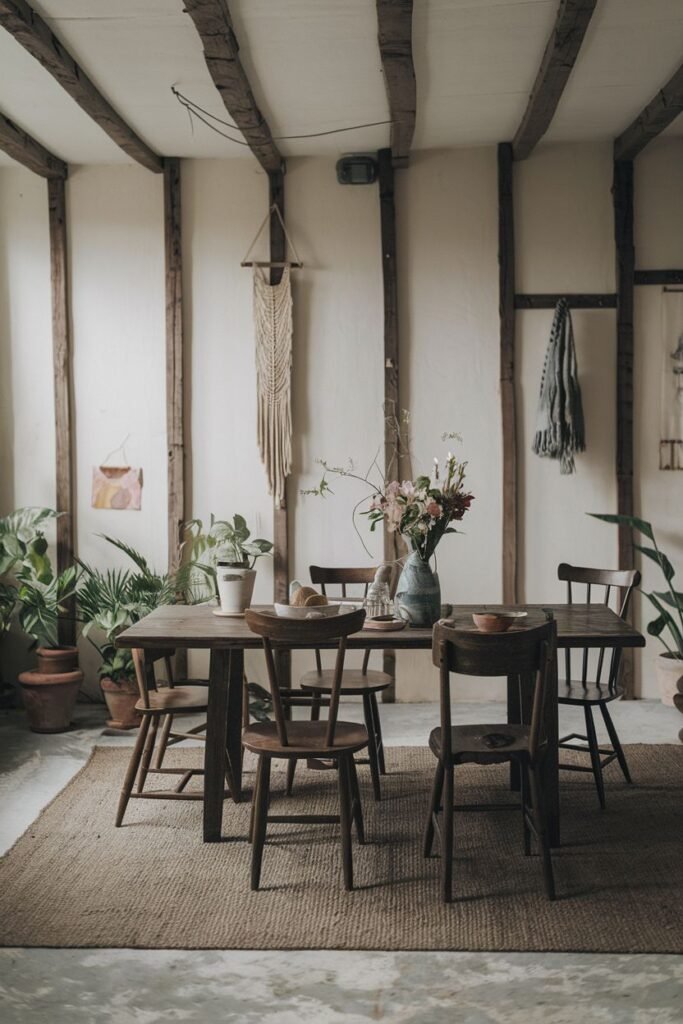
Use a dark wooden table and simple wooden chairs. Place a large natural fiber rug under the table. Fill the room with various potted plants of different sizes. Hang textile art or macrame on the walls. Display a vase with flowers on the table.
8. Natural Light and Wabi Sabi Elements
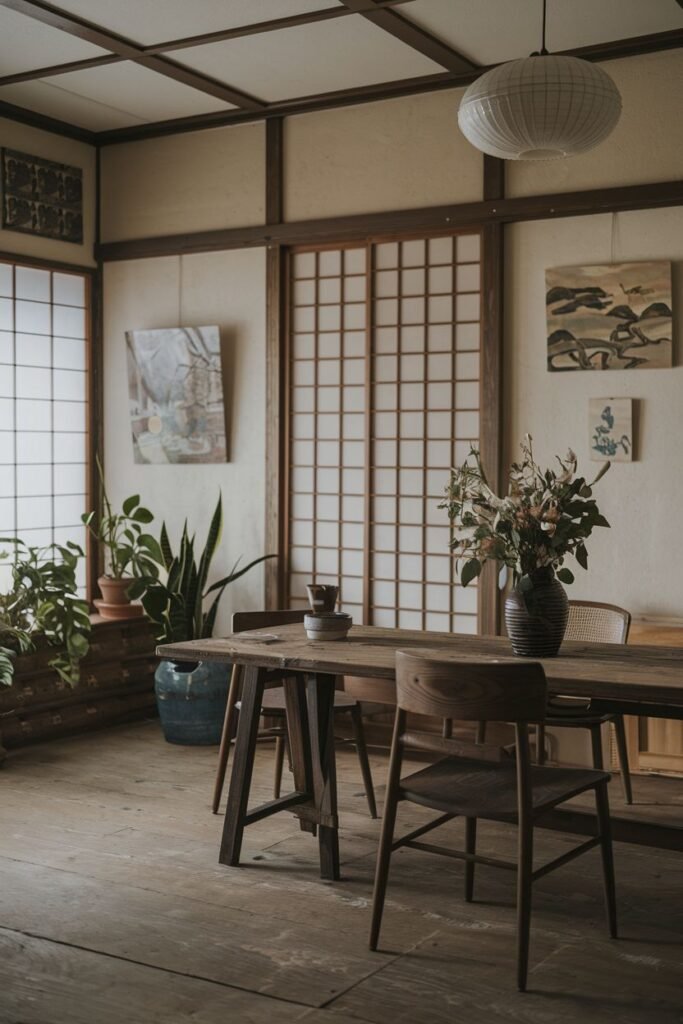
Position a wooden table and chairs with woven seats near a window with lots of natural light. Incorporate shoji screens as window coverings or room dividers. Hang minimalistic artwork on the walls. Add potted plants and a vase with flowers to the space. Use a simple paper lantern as overhead lighting.
9. Create a Rustic and Natural Dining Space
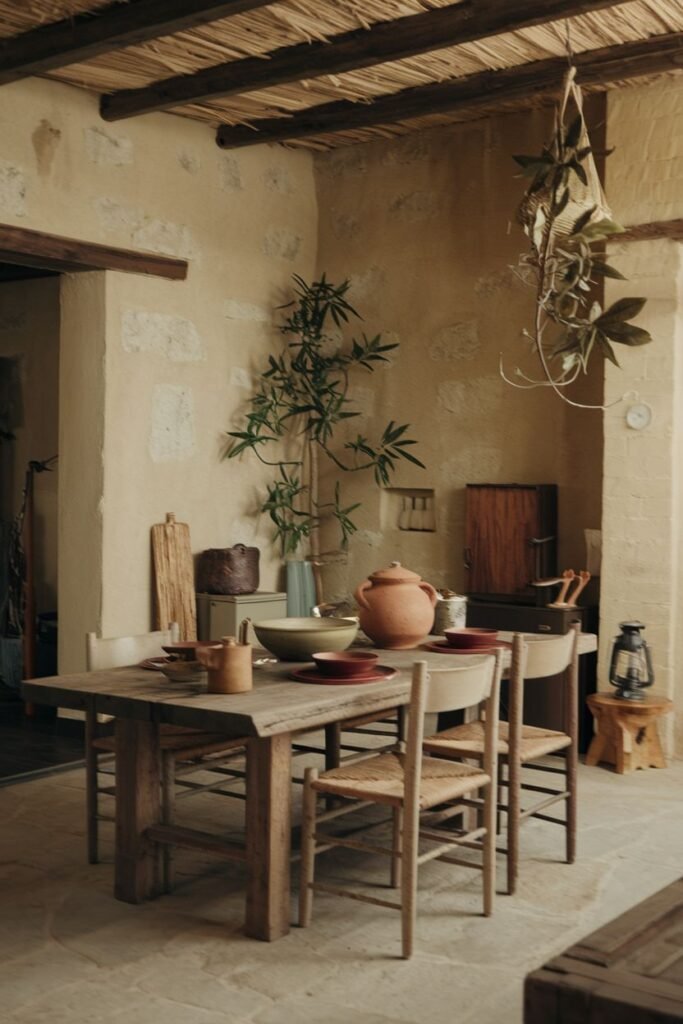
Choose a square wooden table and chairs with woven seats. Place earthenware pots and wooden cutting boards as decor. Hang a simple light fixture from the ceiling. Include large potted plants and smaller decorative items like a lantern and stool.
10. Dark Wood and Shoji Screens for a Calming Atmosphere
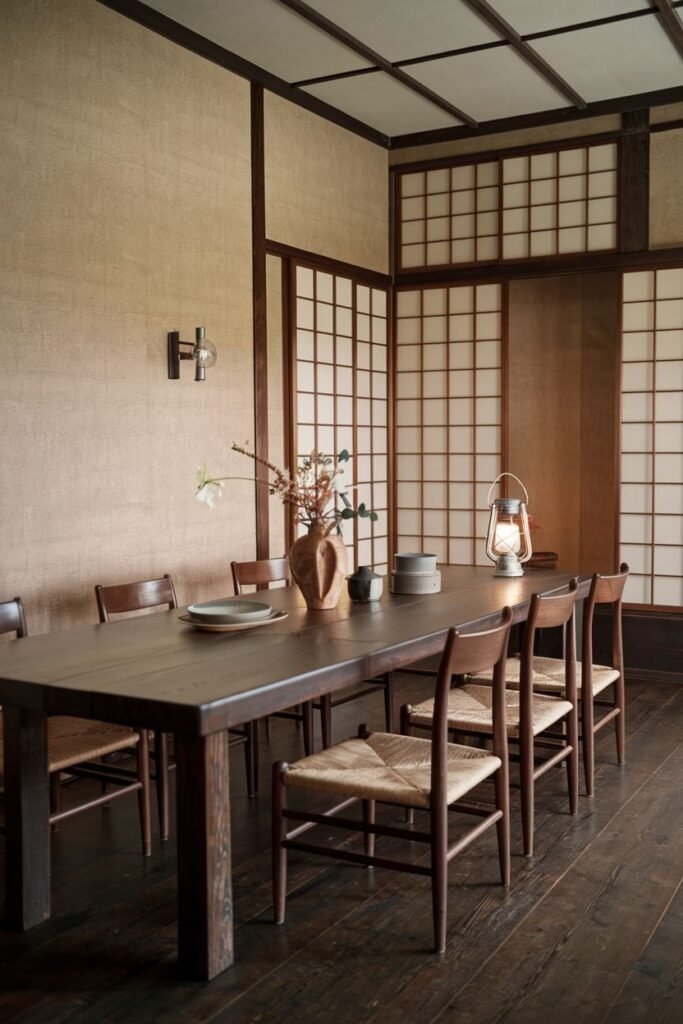
Select a long, dark wooden table with matching chairs. Install shoji screens along a wall to create a diffused backdrop. Use minimalistic decor such as a vase with a single branch and simple cups. Hang simple wall sconces or place a lantern on the table for lighting.
11. A Natural and Serene Dining Room with Hanging Plants
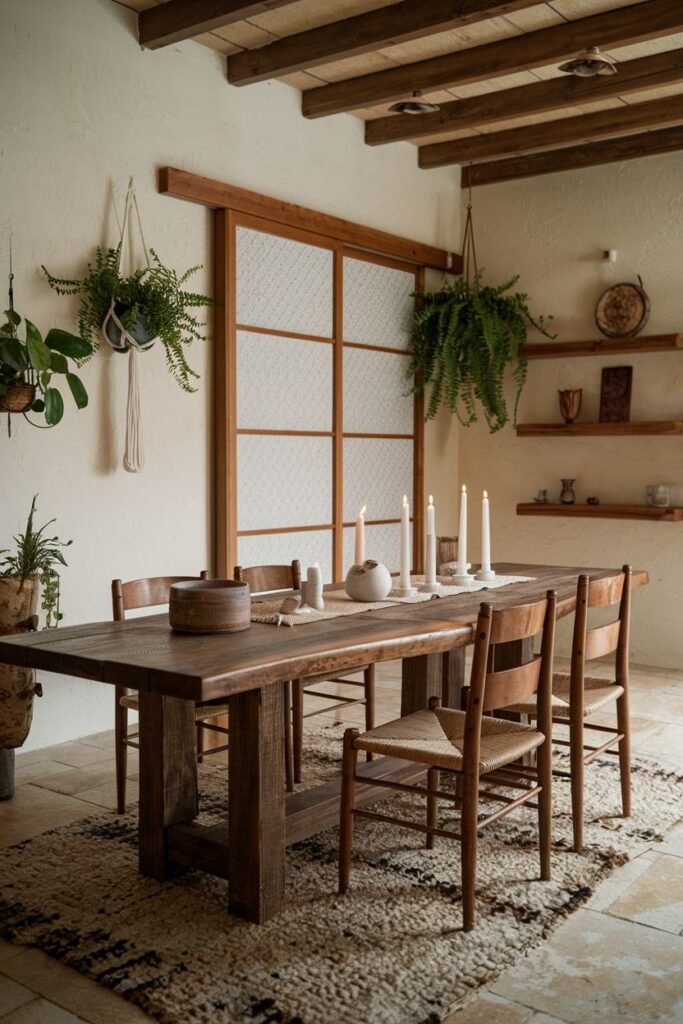
Feature a large, heavy wooden table and chairs with woven seats. Drape a textured rug beneath the table. Hang potted ferns and other plants from the ceiling. Utilize sliding doors with translucent panels. Decorate the table and nearby shelves with candles, vases, and other simple objects.
12. Simple Wood and Pale Colors for a Natural Look
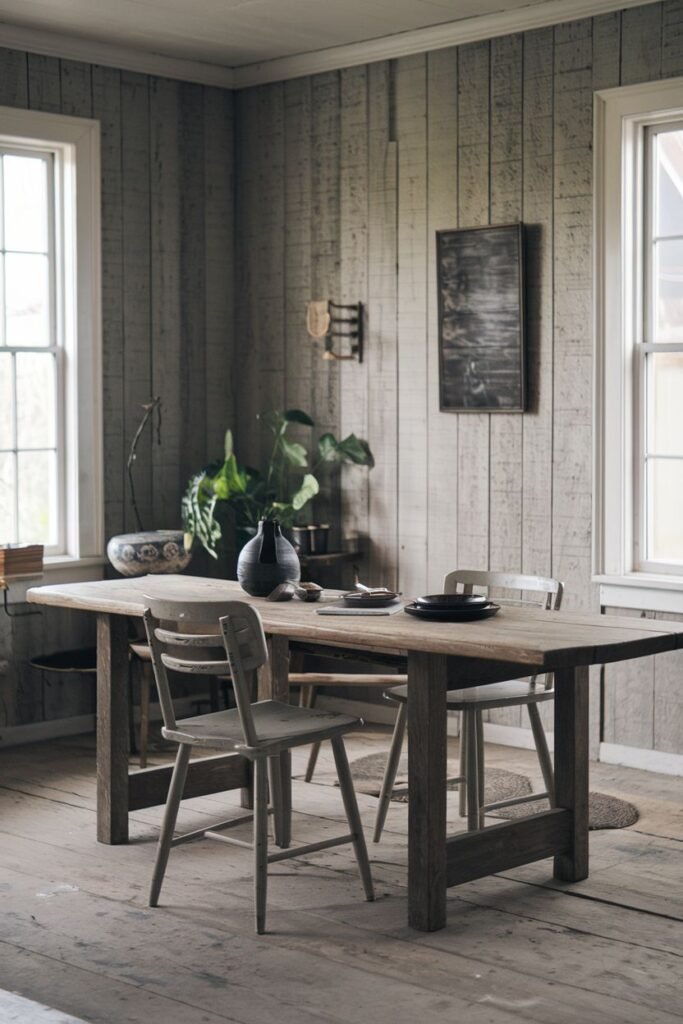
Choose a light-colored wooden table and chairs in varying shades of wood. Keep wall colors light and natural. Place simple decor on the table, like a vase and plates. Add a potted plant in the corner. Hang minimalistic art on the wall.
13. Modern Wabi Sabi Dining Room with Ambient Lighting
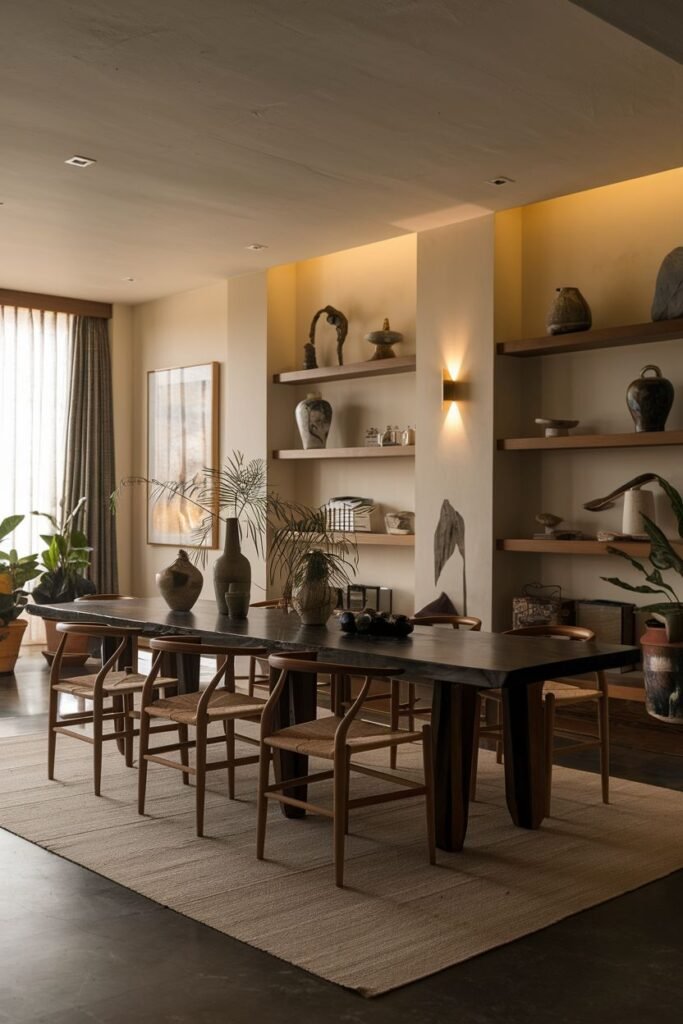
Select a dark, polished wooden table and chairs with woven seats. Position the table on a natural fiber rug. Arrange multiple shelves on the walls and display vases, pottery, and sculptural objects. Use warm, indirect lighting to create a cozy ambiance. Add potted plants to the room.
14. A Warm and Natural Dining Area with Traditional Japanese Elements
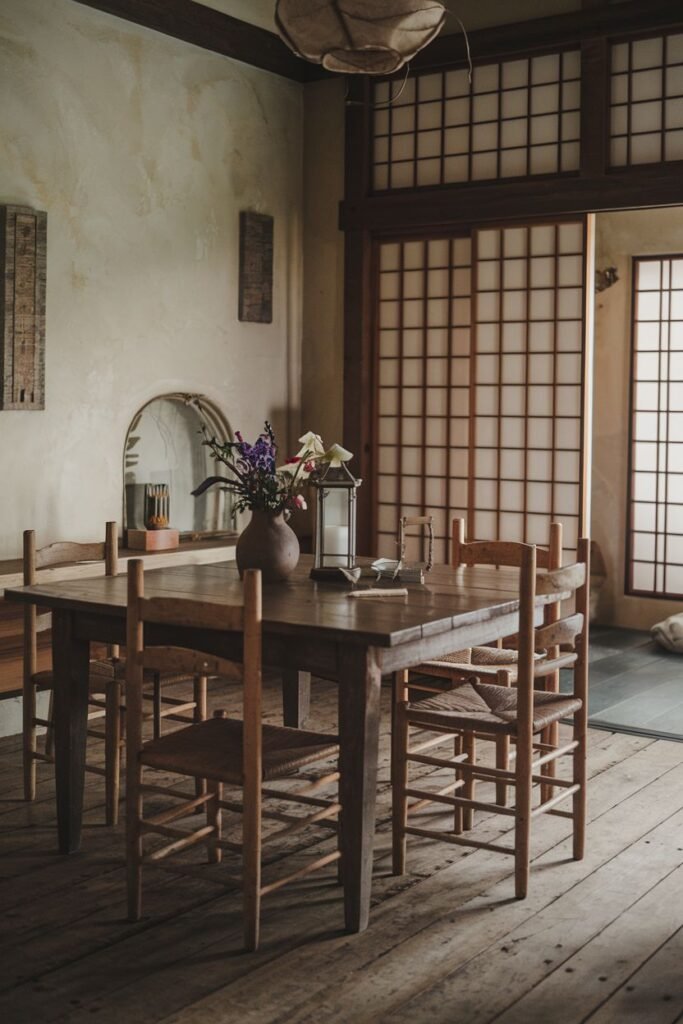
Use a medium-toned wooden table and chairs with woven seats. Incorporate shoji screens on windows and as door coverings. Place a vase with colorful flowers and a lantern on the table. Decorate with a circular mirror and other rustic items.
15. Industrial and Natural Wabi Sabi Combination
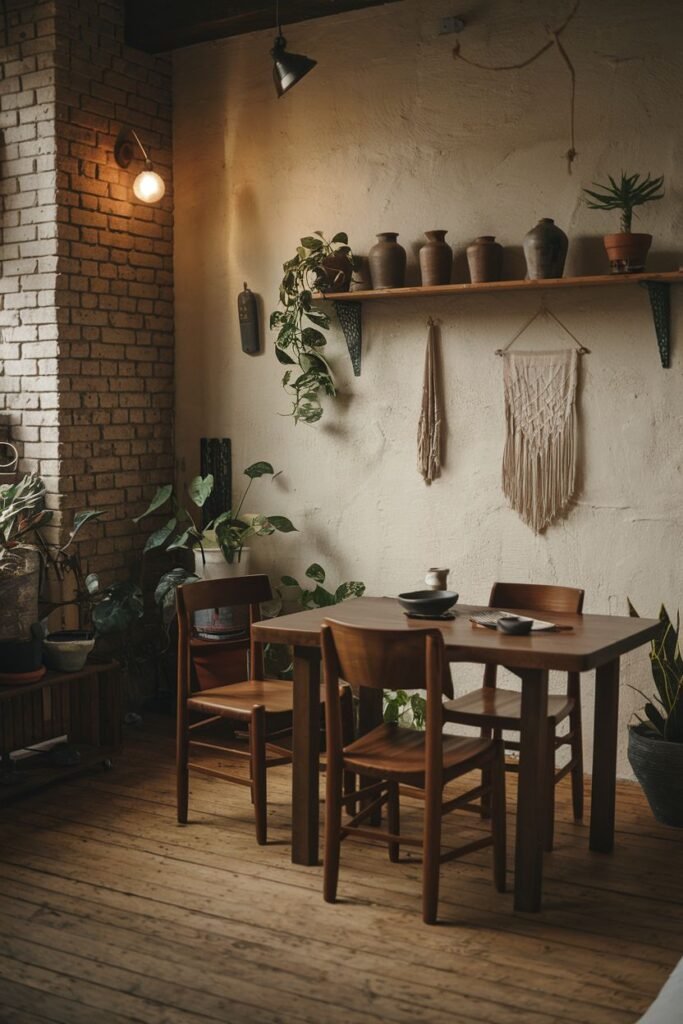
Feature a square wooden table and simple wooden chairs. Utilize exposed brick walls and textured plaster. Install industrial-style lighting fixtures. Hang shelves to display a collection of vases and small objects. Incorporate potted plants to soften the industrial elements.
16. Textiles and Textures in a Natural Dining Setting
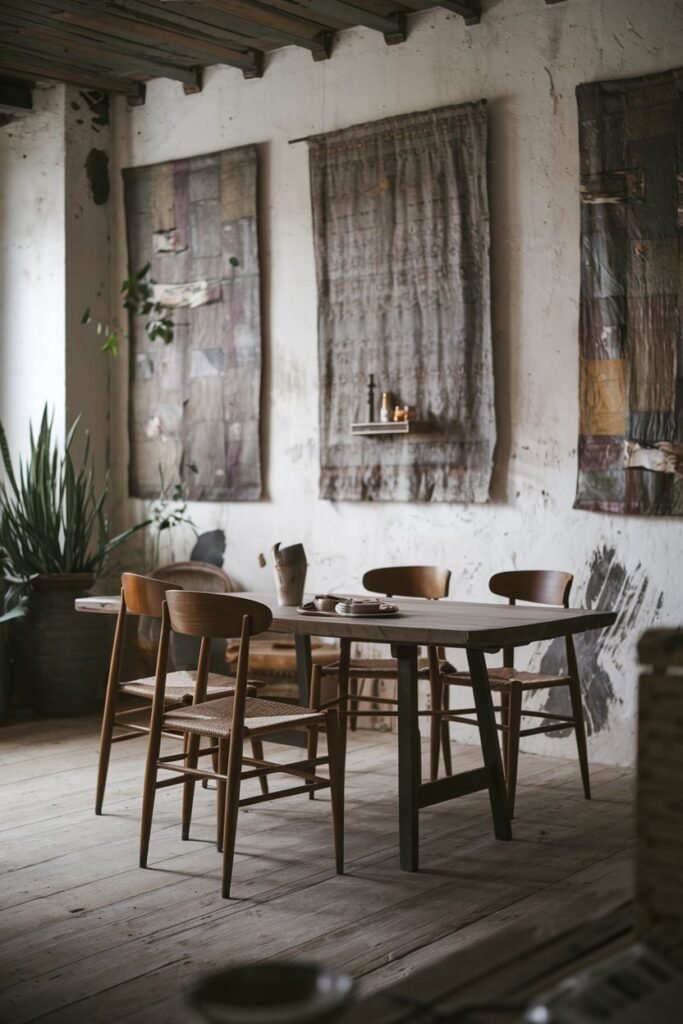
Select a wooden table and chairs with mixed styles, including some with woven seats. Hang large textile pieces on the walls as artwork. Place potted plants and a vase on the table. Note the use of different textures on the walls.
17. A Grand Natural Dining Table with a Unique Base
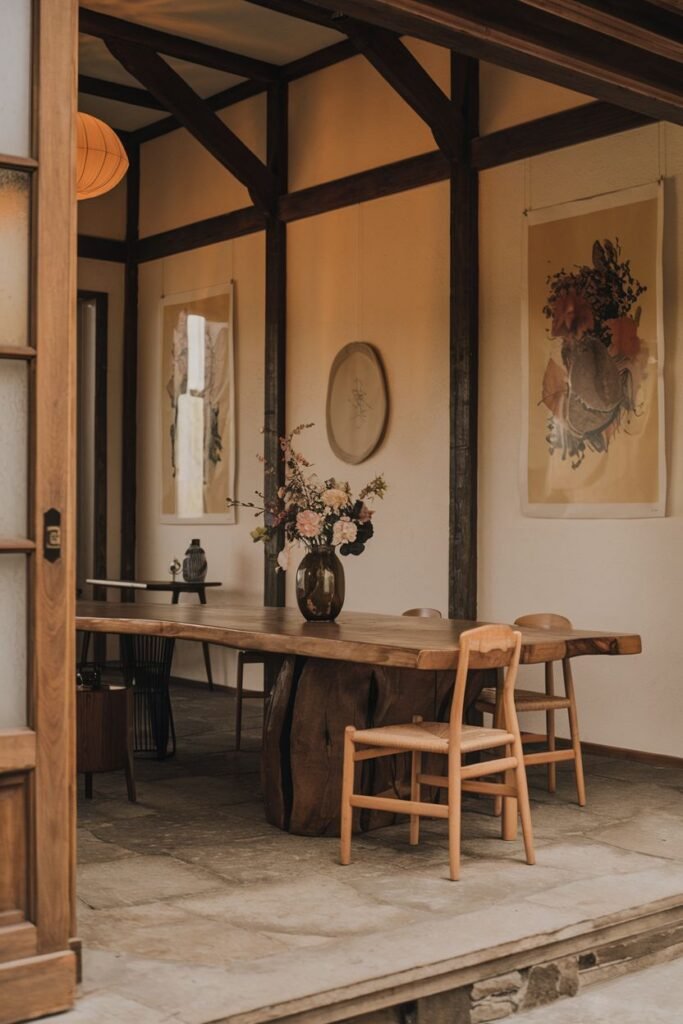
Choose a very large, live-edge wooden table with a striking, natural wooden base. Pair it with chairs of different styles, including some with woven seats. Hang artwork and a circular woven piece on the walls. Place a vase with a large floral arrangement on the table.
18. Wabi Sabi Dining Room with Vintage Furniture
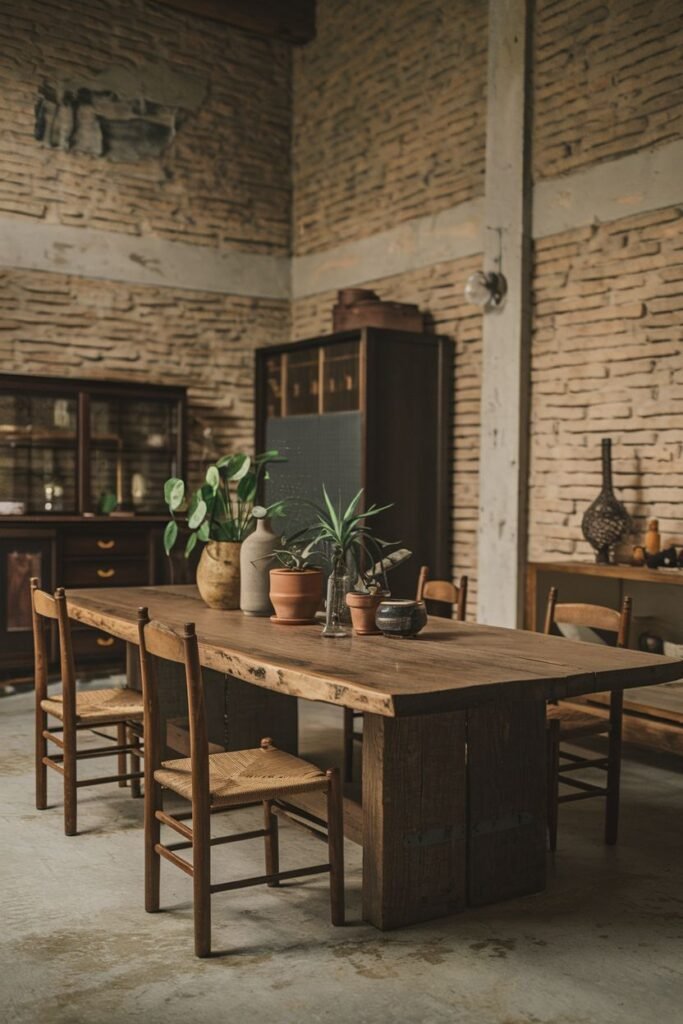
Utilize a large, dark wooden table with a substantial base. Surround it with chairs featuring woven seats. Incorporate vintage cabinets or sideboards for storage and display. Arrange potted plants and vases on the table and furniture. Note the exposed brick and concrete floor.
19. Brick Walls and Natural Wood for a Serene Space
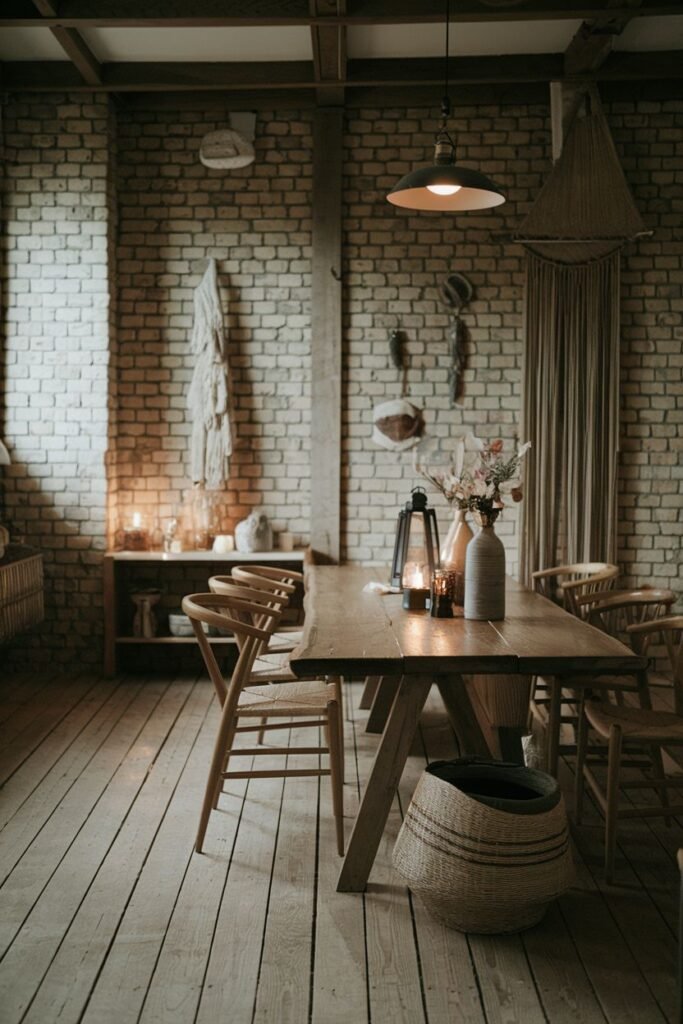
Place a long, natural wooden table with a unique base in a room with exposed brick walls. Use chairs of varying styles, including Wishbone chairs and those with woven seats. Hang a simple light fixture and decorative objects on the walls. Decorate the table with vases, candles, and a lantern. Include a large woven basket on the floor.
20. Outdoor Wabi Sabi Dining Area
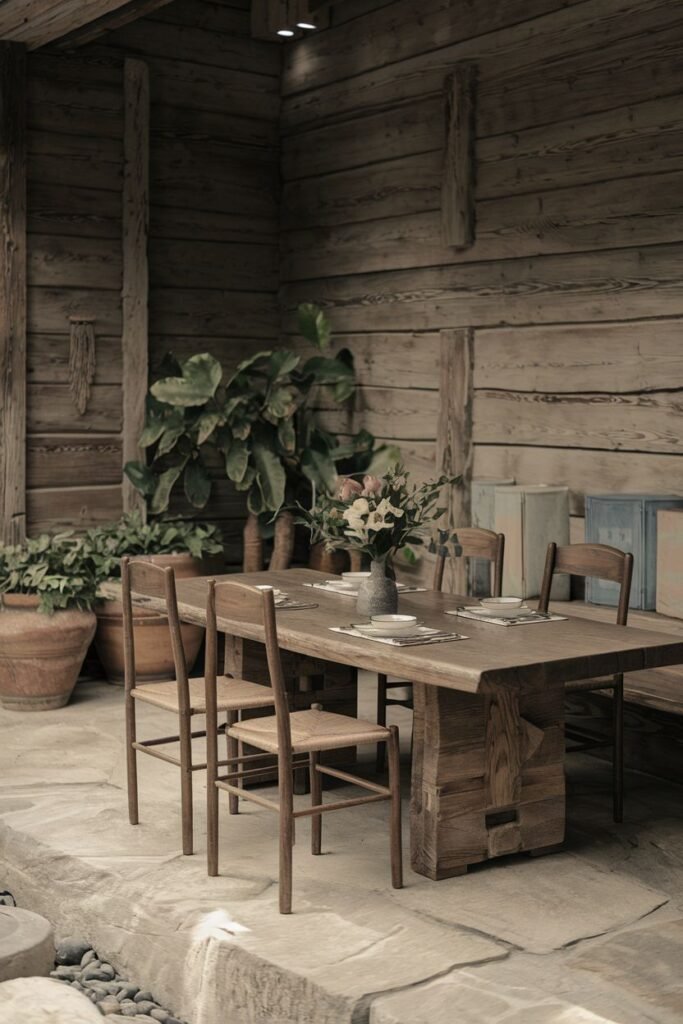
Set up a large, sturdy wooden table with a substantial base on a stone patio. Use chairs with woven seats. Incorporate large potted plants around the area. Note the exposed wooden wall in the background. Place simple tableware and a vase with flowers on the table.
21. Bright and Natural Dining Room
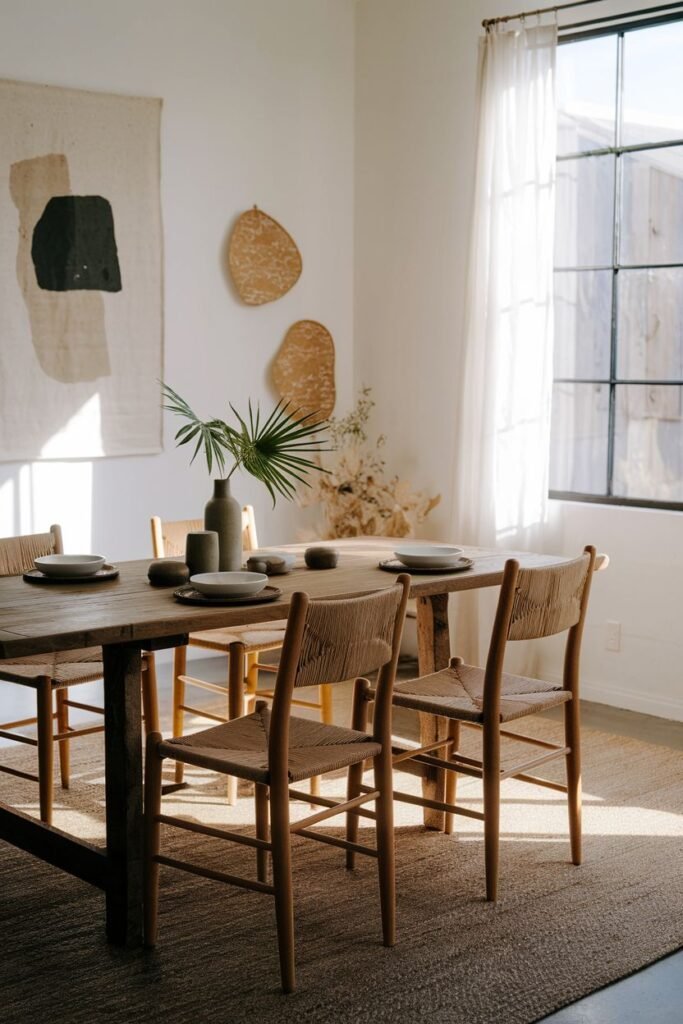
Choose a light-colored wooden table and chairs with woven seats. Position the table on a natural fiber rug. Allow ample natural light to enter through a large window. Decorate the walls with textile hangings and woven decorative items. Place a vase with greenery on the table.
22. Large Dining Table in a Natural Stone Setting
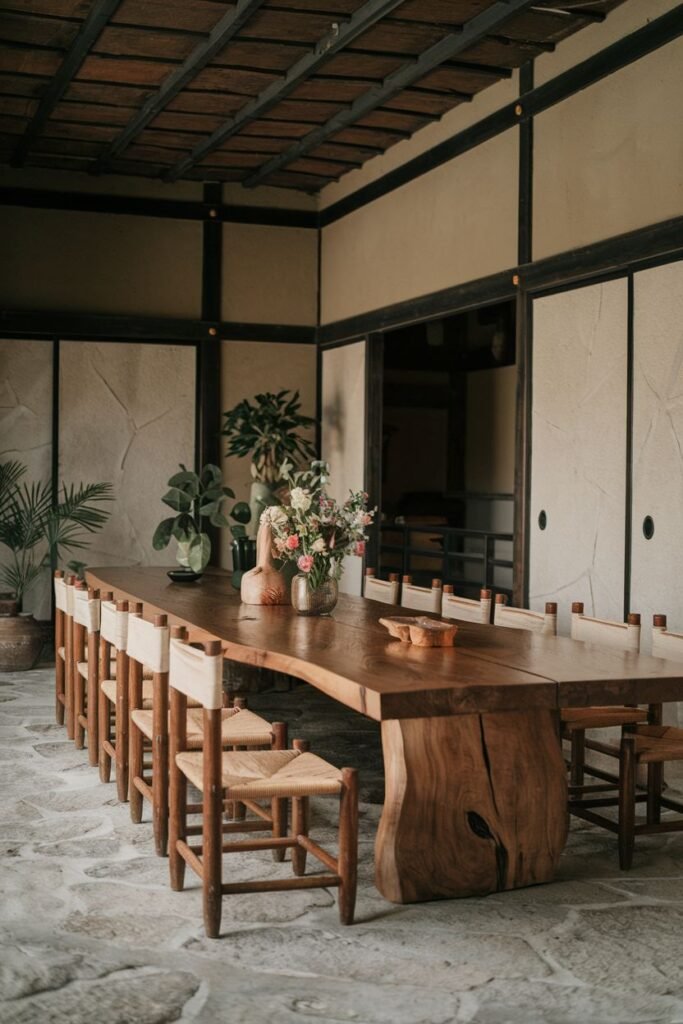
Feature a very large, live-edge wooden table with a significant natural base. Surround it with numerous chairs of different styles, including some with woven seats. Note the stone floor and wooden ceiling beams. Use sliding doors and potted plants. Decorate the table with vases and decorative bowls.
23. Natural Serene Dining Room with Exposed Brick
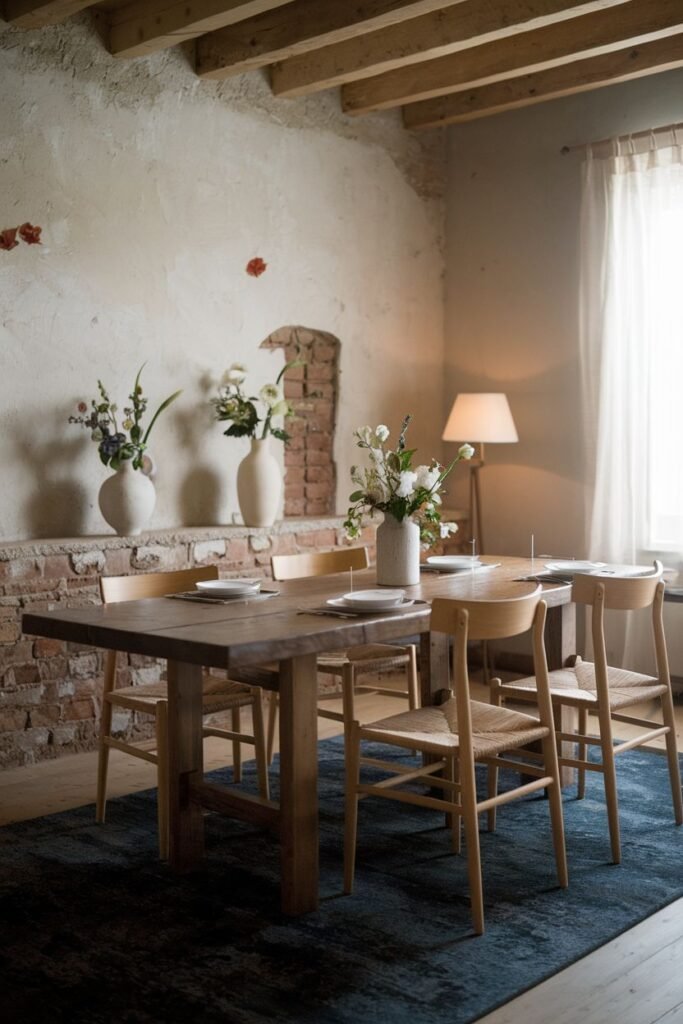
Use a medium-toned wooden table and chairs with woven seats. Place the table on a dark, textured rug. Incorporate exposed brick on the walls. Display vases with flowers on the table and a wall shelf. Use a floor lamp for additional lighting.
24. A Natural Wabi Sabi Dining Room with Character
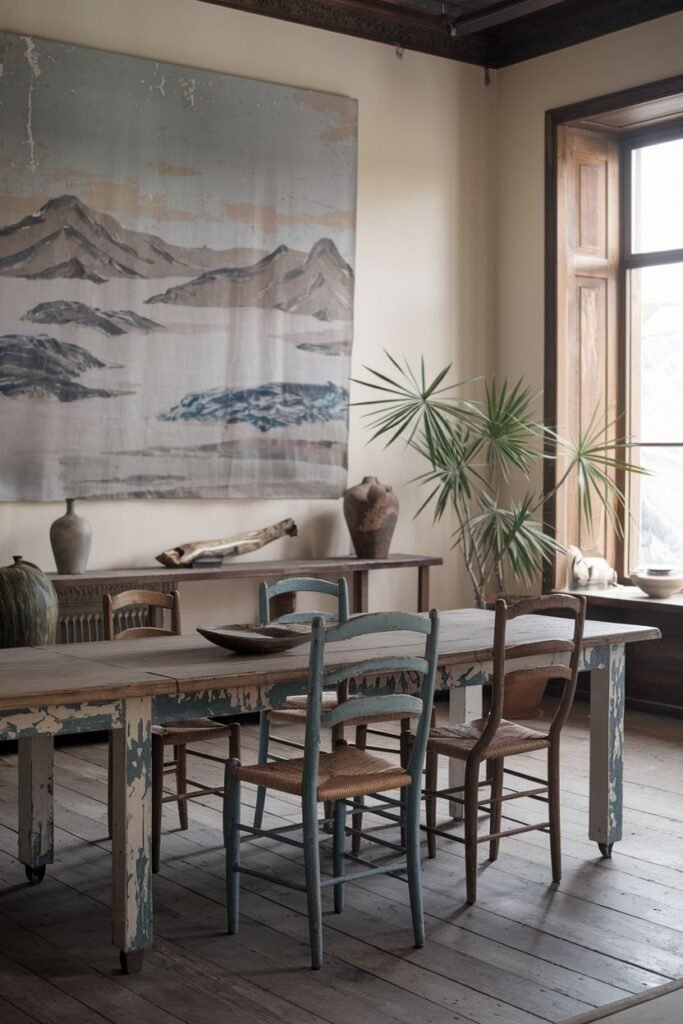
Select a long, painted wooden table with a distressed finish. Use chairs of different styles and colors, including some with woven seats. Hang a large textile artwork depicting a landscape on the wall. Include vases and natural objects as decor. Note the wooden floorboards and large window.
Conclusion
Creating a Wabi Sabi dining room involves a deliberate selection of natural materials, a focus on simple forms, and an appreciation for the inherent character of each element.
From incorporating raw wood and textured walls to utilizing natural light and organic textiles, the ideas presented demonstrate how to achieve a tranquil and authentic dining experience.
By embracing the Wabi Sabi aesthetic, these concepts aim to design spaces that are not only visually harmonious but also promote a sense of peace and connection with the natural world.
